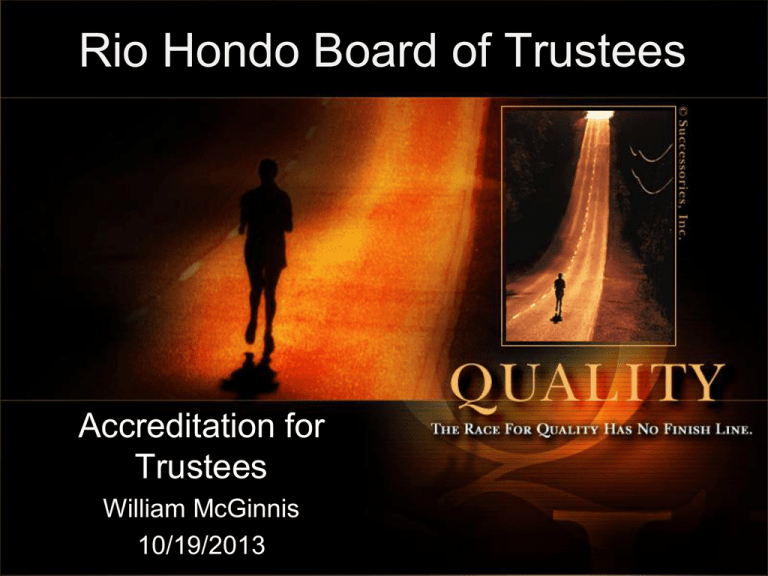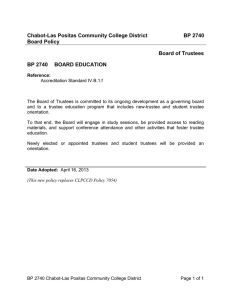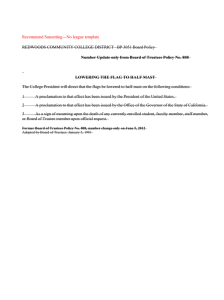Rio Hondo Board of Trustees Accreditation for Trustees William McGinnis
advertisement

Rio Hondo Board of Trustees Accreditation for Trustees William McGinnis 10/19/2013 Ground Rules • • • • • • • • • Be on time (from breaks). Everyone participates. Stay within the agreed upon objective / agenda. No private conversations. Say what’s on your mind to all. Listen for content before forming an opinion (open your mind to others). Suspend judgment until there has been sufficient discussion and data. Be specific and use examples, provide data when possible. It is okay to disagree but be open to new ideas and don’t be caught up in your own visions. • All topics/issues are fair game. • No cheap shots (woofing / trash talking). • No Hogging / Frogging /or Bogging. 2 What We’ll Discuss • Accreditation - What & Why. • The Standard IV Measures of BOT and Performance Discussion. • Trustee Activities in the Accreditation Process. • Questions / Comments. 3 The Purposes of Regional Accreditation • Provide quality assurance to the public, to students, to other institutions that an institution is achieving its stated mission • Give credibility to degrees and credentials awarded to students • Stimulate institutional improvement through evaluation, planning, implementation and evaluation again 4 What is the Process for Comprehensive Review? • Institutional self evaluation • External evaluation by professional peers • Commission evaluation -the body of 19 Commissioners renders a judgment on the accreditation status of the institution • Institutional improvement A Six-Year Cycle of 5 Review What are the Accreditation Standards? • Standard I: Mission and Institutional Effectiveness – Data-driven assessment and improvement, focus on learning • Standard II: Student Learning Programs and Services – Instructional, Support and Learning Services, focus on learning • Standard III: Resources – Deployment of resources toward achievement of mission, fiscal integrity • Standard IV: Leadership and Governance – Leadership to focus institution on mission, roles of governance structures, CEO and governing board 6 Are Institutions Expected to Meet All Accreditation Standards at All Times? • Member institutions agree to adhere to Accreditation Standards at all times when they seek initial accreditation • Institutions should have ongoing internal quality review and quality improvement processes – program review, planning, implementation of changes, assessment of learning outcomes, evaluation of institutional effectiveness • Six-year accreditation checks on what should be ongoing institutional practices to review and improve quality 7 If the institution is found to be noncompliant with the Standards, how long may it take to comply? • Federal two-year rule • Commission works with institutions as they improve, and can extend the time allowed for “good cause” • Accreditation team recommendations feed into institutional plans for improvement 8 Assuring Compliance • How does your Board assure itself that the college in your District complies with the ACCJC Accreditation Standards? • Focus on the “what” not the “how.” 9 ACCJC Data on Sanctions – 4 years Colleges on Sanction January 2009 – January 2012 Top Deficiencies Causing Sanctions Please note category increasing in frequency in table above 10 Role of Trustees in Educational Quality STEWARDSHIP OF EDUCATIONAL QUALITY AND FISCAL STABILITY (STANDARDS II & III) • The governing board is responsible for the quality, integrity and financial stability of the institution and for insuring that mission is being carried out. • The governing board is responsible for ensuring that the financial resources of the institution are used to provide a sound educational program 11 Standard IV-B: Trustees Role 12 Trustees Have Two Challenges 1) Mission Directed Leadership, and 2) High Performance of the Board and Institution Setting standards of excellence and measuring performance linked to the District’s goals will help meet both challenges. To perform well Trustees must be accountable as well as hold others accountable. (Standard IV-B) 13 Role of Trustees - Mission • The institution’s educational mission is clearly defined, adopted and published by its governing board consistent with its legal authorization, and is appropriate to a degree-granting institution of higher education and the constituency it seeks to serve. The mission statement defines institutional commitment to achieving student learning. (Standard IV-B-.1) 14 Role of Trustees: Policy-Making • Institutions recognize the designated responsibilities of the governing board for setting policies and of the chief administrator for the effective operation of the institution. • The institution has a governing board responsible for setting policies to assure the quality, integrity and effectiveness of the student learning programs and services and the financial stability of the institution. (Section IV-B-1) 15 Policy Governance • The governing board establishes policy to assure the quality, integrity and effectiveness of the student learning programs and services, and the financial stability of the institution. (Standard IV-B-1.c) • The governing board has ultimate responsibility for educational quality, legal matters and financial integrity. (Standard IV-B-1.b) 16 Academic Measures • Completion of Student Learning Outcomes Program. • Current Educational Master plan. • Performance Standards for: – Student Course Completion rates – Student Retention rates – Student Degree Completion number – Student Certificate Completion number – Student Transfer Rates to 4 year schools. Board Discussion • What would great student achievement look like in your college? • What policy changes might the Board consider that would have a positive impact upon student achievement? Responsibility of Trustees: Wise Use of Resources to Achieve Mission • Financial Resources are sufficient to support student learning programs and services and to improve institutional effectiveness. The distribution of resources supports the development, maintenance and enhancement of programs and services. The institution plans and manages its financial affairs with integrity and in a manner that ensures financial stability. The level of financial resources provides a reasonable expectation of both short term and long term financial solvency. Financial planning is integrated with institutional planning. 19 Sample Financial Benchmarks • Measurements: – Deficit Spending – Impacts upon the General Fund Balances – Costs of Retirees Health Insurance Coverage – Long Term Costs of Labor Agreements – Long Term Costs of Debt Service – Enrollment & productivity trends – Condition of Facilities • Example: The % of $ value of total out years for labor agreements divided by current value of labor agreements as compared to the 20 projected COLA % changes. Good to Great • Good Boards assure their budgets are balanced and do not create potential unfunded liabilities for the District. • Great Boards assure their budget expenditures are also linked and correspond to the priorities in the District’s Mission and Educational Master Plan. 21 Board Discussion • Describe what your District budget would look like to allow student achievement to improve? • How can your District link its’ budget to your District’s Mission? Policy Setting is Job #1 • The governing board publishes its bylaws and policies, and keeps them current. (Standard IV-B-1.d) • Requires periodic update of existing policies and adoption of new policies as needed. • Policies focus on the “what” not the “how.” to avoid micromanagement. Good to Great Boards • Poor Boards respect their “sacred cows.” • Good Boards try to work around the cows. • Great Boards hold barbeques! • What are your District’s “sacred cows?” 24 District Policies • Test policies by linking to Mission, Strategic Plan, Budget, and do a “Sacred Cow” test! • Hold all accountable (administration / faculty) • Focus on the entire community’s needs – not the needs of special groups. • Fulfills Board’s responsibility as Leaders. (Standard IV-B-1.b & d) 25 Responsibility of Trustees: Coherent Action and Direction • Once the board reaches a decision, it acts as a whole. It advocates for and defends the institution and protects it from undue influence or pressure. • The governing board has ultimate responsibility for educational quality, legal matters and financial integrity. • The governing board has a program for board development and new member orientation, and a mechanism for providing continuity of membership and staggered terms of office. Standard IV-B-1.a) 26 Accountability Responsibilities • Process / Frequency / Accountability • Focus on Data such as Lagging & Leading Indicators not stories / feelings • Coordination with Strategic Plan / Mission and Vision » (Standard IV-B-1.e) 27 Build a Team • To achieve high performance, Trustees need to work as a team and critical to being a team is retaining a climate of trust and respect. • The President is also on the Team. 28 Board Discussion • What would Board discussions look like if your Board and CEO operated as a team? • What would your Board need to do to allow the “team” type discussions to occur? Diversity of Opinions / Single Focus • Many boards appear afraid to engage in open and contested discussions of policy issues before a vote is taken. • But to do so effectively you need a base of Trust & Respect and a focus on community needs and Student Success. • Remember Trustees represent the entire community not groups or special interests. • Once a Board decision is made all Trustees are expected to support the majority decision. 30 » (Standard IV-B-1.a) Responsibility of Trustees: Integrity in Board Operations • The governing Board publishes board bylaws and policies specifying the board’s size, duties, responsibilities, structure, and operating procedures (e.g., Robert’s Rules, Brown Act, etc.) • The governing board acts in a manner consistent with its policies and bylaws, and evaluates and revises its own practices as needed. • The governing board’s self evaluation processes are clearly defined, implemented, and published. • The board has a code of ethics and a policy for dealing with behavior that violates the code. (The board members are willing to require proper behavior of their colleagues. • (Standards IV-B-1.d,e,g, & h) 31 Board Quality is Job 1 • Board building is on-going, a process of continuous improvement, which means Boards must keep coming back to the same questions about purpose, resources, and effectiveness. • Ask yourself, “What can I do as a Trustee to make our Board more effective?” “To help our President be successful?” Then ask. “What can our Board do better?” 32 Trustee Development Discussion • What kind of training or professional trustee development does your Board participate in either individually or as a team? • What is in your Board policies on Trustee Development and Education? • What corrective actions are in your Board’s Policy on Trustee Code of Conduct/Practices? (Standard IV-B-1.f) 33 Self-Assessment / QI • Self-assessment should not be a cursory glance in the mirror or performed in a vacuum. • Rather it needs to be a periodic & exhaustive culling of quantitative and qualitative data. • Once you identify the issues, the Board needs a self-improvement plan or goals and time lines. • Return to the issues at 6 months or a year and re-evaluate. Complete the Quality Improvement circle. 34 Board Self-Evaluations • Performed annually / timely review of results / establishment of goals / corrective actions. • More specifically, Boards must recognize which Trustees need help, and then provide the help thru mentoring, education, coaching, establishing ground rules, and enforcing state and local laws, policies, regulations and ground rules. • Only the Board can regulate its members! 35 Role of Trustees - Ethics • The governing board has a conflict of interest policy that insures that its interests are disclosed and that they do not interfere with the impartiality of governing board members or outweigh the greater duty to secure and ensure the academic and fiscal integrity of the institution 36 Board Behavior is Important • Board behavior sends a message –Focus on Student Success & Learning –Represent the entire Community –Support innovation and leadership –Develop a team culture including the President 37 Steps for Performance Changes • • • • • • • • • Board Policies New Trustee Orientation / Changes in BOT Mentoring Prompt feedback/correction when actions stray Continuous Training Individual Coaching Board Warning Board Censorship Legal Action 38 Role of Trustees: Partnership with the CEO • The governing board has the responsibility for selecting and evaluating the district/system chief administrator. • The governing board delegates full responsibility and authority to the chief administrator to implement and administer board policies without board interference and holds the CEO accountable for the operation of the district or college. (Standard IV-B-1.j) 39 The Board / CEO Team • Build Trust between the Board & the CEO • Avoid Public Conflict – Be Respectful • Expect & Provide Commitment to Board decisions • Hold the CEO Accountable • Focus on Results • Maintain Open Communication • The CEO is not only an employee but also a team member! 40 Great Boards Make Great CEOs • • • • Build a relationship Understand the needs of your CEO Motivate not regulate, bench your ego. First ask what you can do & then what the Board can do. • Maintain the relationship by communicating • Set clear and measurable goals • Create the conditions for success Focus on the right work! Establishing and sticking to an overarching level of engagement helps Trustees set expectations and ground rules for their roles relative to the President’s role. (Focus on “what” not the “how”, and on the needs of the entire community; finally don’t allow your focus to be diverted.) 42 Board Leadership w/CEO • Board leadership is not about forcing your will on the President or the Board, rather is it about the art of letting go to avoid micromanagement. • Building Trust and Respect creates the environment for success. Summary • Work as a Team w/ President & w/ BOT • Build trust, avoid destructive conflict, provide commitment , be accountable, and focus on results. • Act with intelligence, respect, care, and integrity • Base decisions on data not stories • Be future-oriented • Represent the entire community / not single interests. 44 Trustees Activities • • • • • 18 months prior to visit. 3 - 5 months prior to visit. During the visit. After the visit. Follow up. 18 Months Prior to visit • Review self-study process. • Review status of previous Commission recommendations. • Review Trustee responsibilities. • Participate in Trustee Accreditation training. 3 - 5 Months Prior to visit • President’s Review of Self-Study • Presentation to Board for Review • Board Discussions in Open Sessions • Approval of Final Self-Study • Prepare for Trustee Interviews During the Visit • Greet Visiting Team – 1st day. • Participate in Trustee Interviews. –Be prepared –Be honest • Attend Team Report Session on final day. After the Visit • Review Summary of Team Report and review any response to Commission. • Review Commission Decision and Recommendations. • Assure President develops a plan to respond to recommendations. • Establish a Periodic Reporting schedule w/President for responses to Commission Report. • Begin planning for next Commission visit. Follow Up • Coordinate with President to assure all recommendations are responded to in the required time. • Prepare for any follow up reports or visits. • Take corrective actions if recommendations concern Board practices. Hold yourself accountable. Walk to Success • Poor Boards ”Talk & don’t Listen.” • Good Boards “Listen & Talk the Talk” • Great Boards “Listen and then Walk the Talk.” 51 Board Discussion • What would “walking the talk” look like with your Board? • What kinds of changes do you need to make to be a Great Board? Trustee Discussion? • Your Questions / Comments? • Thank You for your attention. – Bill McGinnis


